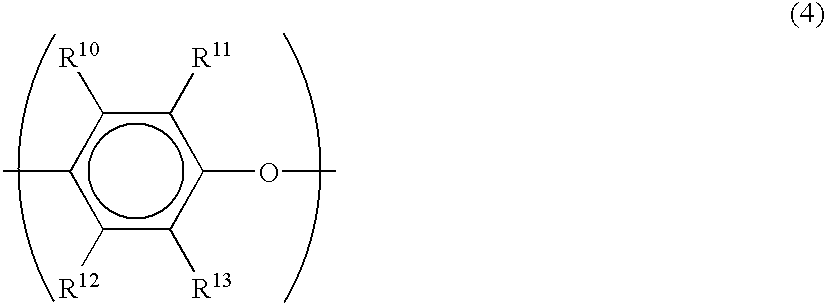(Meth) acryloyl group-containing compound and method for producing the same
- Summary
- Abstract
- Description
- Claims
- Application Information
AI Technical Summary
Benefits of technology
Problems solved by technology
Method used
Image
Examples
example 1
[0131] 114.2 g (hydroxyl group=1 mol) of bisphenol A, 0.017 g (0.1 mmol) of p-toluenesulfonic acid, and 300 g of 2-butanone as solvent were put into a liter flask equipped with a stirrer, a thermometer, a condenser and a nitrogen-introducing tube. The material was agitated and then was cooled to 10.degree. C. in an ice bath. Thereafter, 186.2 g (1 mol) of 2-(vinyloxyethoxy) ethyl acrylate (hereinafter referred to as "VEEA") was dropped and added into the resulting solution over 1 hour, and the temperature was returned to room temperature, and then the mixture was allowed to react for another two hours. The reaction solution was neutralized with a sodium hydroxide solution of 1 mol / L and was filtered, and then the reaction product was subjected to re-precipitation using n-hexane, followed by filtration and drying.
[0132] The material thus obtained was identified by means of .sup.1H-NMR and IR. As a result, it was confirmed that the above-mentioned material of the reaction product is a...
example 2
[0133] 183.5 g of a bisphenol A epoxy resin (YD-127, product of Tohto Kasei Co. Ltd.) and 0.734 g of triethylbenzyl ammonium chloride were put into a 1 liter flask equipped with a stirrer, a thermometer, a condenser and a nitrogen-introducing tube. Thereafter, the mixture was allowed to react at 115.degree. C. over 5 hours while 72 g of acrylic acid were dropped and added over 2 hours. 0.729 g of hydrochloric acid and 441.7 g of 2-butanone as solvent were added to 255.5 g (hydroxyl group=1 mol) of the obtained epoxy acrylate and stirred, and then the mixture was cooled to 10.degree. C. in an ice bath. Then, 186.2 g (1 mol) of VEEA were dropped and added over 1 hour into the resulting solution, and the temperature was returned to room temperature, and then the mixture was allowed to react for another two hours. The reaction solution was neutralized with a sodium hydroxide solution of 1 mol / L and was filtered, and then the reaction product was subjected to re-precipitation using n-hex...
example 3
[0135] 90 g (0.9 mol) of methyl methacrylate, 13 g (0.1 mol) of 2-hydroxyethyl methacrylate, and 240 g of 2-butanone were put into a 0.5 liter flask equipped with a stirrer, a thermometer, a condenser and a nitrogen-introducing tube. After the air was sufficiently replaced by nitrogen, the temperature was raised to 70.degree. C. Then, 1.03 g of 2,2'-azobis(2,4-dimethylvaleronitrile) dissolved in 2-butanone was introduced into the reaction mixture over 1 hour, and then it was polymerized at 70.degree. C. over 5 hours. To 103 g of the methacrylate polymer thus obtained, 0.073 g of hydrochloric acid was added and the material was cooled to 10.degree. C. in an ice bath. Thereafter, 20.02 g (0.1 mol) of 2.-(vinyloxyethoxy)ethyl methacrylate (hereinafter referred to as "VEEM") was dropped and added into the resulting solution over 1 hour, and the temperature was returned to room temperature, and then the mixture was allowed to react for another two hours. The reaction solution was neutral...
PUM
| Property | Measurement | Unit |
|---|---|---|
| Time | aaaaa | aaaaa |
Abstract
Description
Claims
Application Information
 Login to View More
Login to View More - R&D
- Intellectual Property
- Life Sciences
- Materials
- Tech Scout
- Unparalleled Data Quality
- Higher Quality Content
- 60% Fewer Hallucinations
Browse by: Latest US Patents, China's latest patents, Technical Efficacy Thesaurus, Application Domain, Technology Topic, Popular Technical Reports.
© 2025 PatSnap. All rights reserved.Legal|Privacy policy|Modern Slavery Act Transparency Statement|Sitemap|About US| Contact US: help@patsnap.com



